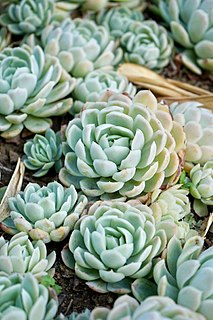
Echeveria is a large genus of flowering plants in the family Crassulaceae, native to semi-desert areas of Central America, Mexico and northwestern South America.

Dudleya is a genus of succulent perennial plants, consisting of about 45 species in southwestern North America.

The Desert Garden Conservatory is a large botanical greenhouse and part of the Huntington Library, Art Collections and Botanical Gardens, in San Marino, California. It was constructed in 1985. The Desert Garden Conservatory is adjacent to the 10-acre (40,000 m2) Huntington Desert Garden itself. The Garden houses one of the most important collections of cacti and other succulent plants in the world, including a large number of rare and endangered species. The 3,000-square-foot (280 m2) Desert Garden Conservatory serves The Huntington and public communities as a conservation facility, research resource and genetic diversity preserve. John N. Trager is the Desert Collection curator.

Echeveria setosa, the Mexican fire cracker, is a species of flowering plant in the family Crassulaceae, native to semi-desert areas of Mexico and common throughout Puebla.

The Huntington Desert Garden is part of The Huntington Library, Art Collections and Botanical Gardens in San Marino, California. The Desert Garden is one of the world's largest and oldest collections of cacti, succulents and other desert plants, collected from throughout the world. It contains plants from extreme environments, many of which were acquired by Henry E. Huntington and William Hertrich in trips taken to several countries in North, Central and South America. One of the Huntington's most botanically important gardens, the Desert Garden brought together a group of plants largely unknown and unappreciated in the beginning of the 1900s. Containing a broad category of xerophytes, the Desert Garden grew to preeminence and remains today among the world's finest, with more than 5,000 species in the 10 acre garden.

Echeveria elegans, the Mexican snow ball, Mexican gem or white Mexican rose is a species of flowering plant in the family Crassulaceae, native to semi-desert habitats in Mexico.

Echeveria agavoides, or lipstick echeveria, is a species of flowering plant in the family Crassulaceae, native to rocky areas of Mexico, notably the states of San Luis Potosí, Hidalgo, Guanajuato and Durango.
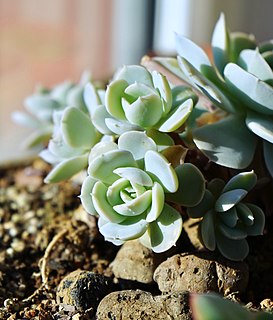
Echeveria runyonii is a species of flowering plant in the family Crassulaceae, that is native to the state of Tamaulipas in Mexico. Several cultivars have been described and cultivated.

Echeveria derenbergii, the painted-lady, is a species of flowering plant in the family Crassulaceae, endemic to Mexico.
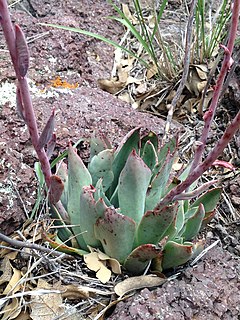
Echeveria strictiflora, the desert savior, is a species of flowering plant in the family Crassulaceae, native to southwestern Texas and to the Chihuahuan Desert of northeast Mexico. Its range consists of several scattered populations, rather than a contiguous range.
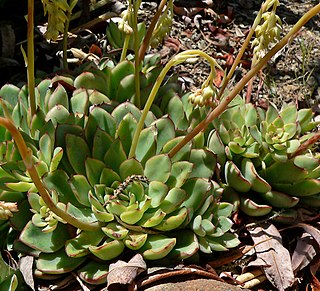
Echeveria pulidonis is a species of flowering plant in the family Crassulaceae, native to central Mexico.

Echeveria multicaulis is a species of plant native to Mexico. It is a member of the genus Echeveria.
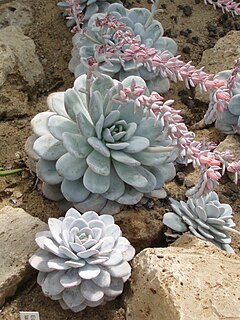
Echeveria laui is a slow-growing perennial succulent plant native to the state of Oaxaca, Mexico. It is a popular decorative plant due it its distinctive pink color.

Echeveria gibbiflora is a species of flowering plant in the family Crassulaceae. It was described by Swiss botanist Augustin Pyramus de Candolle in 1828. It occurs in Mexico and Guatemala.
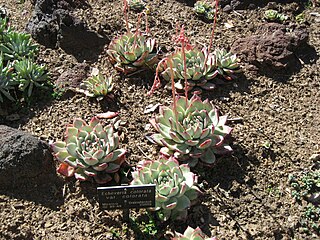
Echeveria colorata, is a species of flowering plant in the family Crassulaceae, endemic to Mexico.
Echeveria atropurpurea is a species of succulent plant in the Crassulaceae family. It is a perennial commonly known as chapetona or siempreviva, and is a endemic to Central Veracruz, Mexico in tropical deciduous forests. It is noted for its fast growing, easy cultivation, and red to yellow flowers. It is currently threatened by habitat loss.

Echeveria amoena is a species of succulent plant in the family Crassulaceae, endemic to semi-arid areas of the Mexican states of Puebla, Tlaxcala, and Veracruz.

Echeveria minima, called the miniature echeveria, is a species of flowering plant in the genus Echeveria, native to northeast Mexico. A succulent, it has gained the Royal Horticultural Society's Award of Garden Merit.

Echeveria pulvinata, called the plush plant, is a species of flowering plant in the genus Echeveria, native to southwest and central Mexico. A succulent, it has gained the Royal Horticultural Society's Award of Garden Merit.

Echeveria secunda, called the glaucous echeveria, is a species of succulent flowering plant in the genus Echeveria, native to Mexico, and introduced to the Dominican Republic, New Zealand, and Vietnam. Its cultivar 'Compton Carousel' has gained the Royal Horticultural Society's Award of Garden Merit.




















